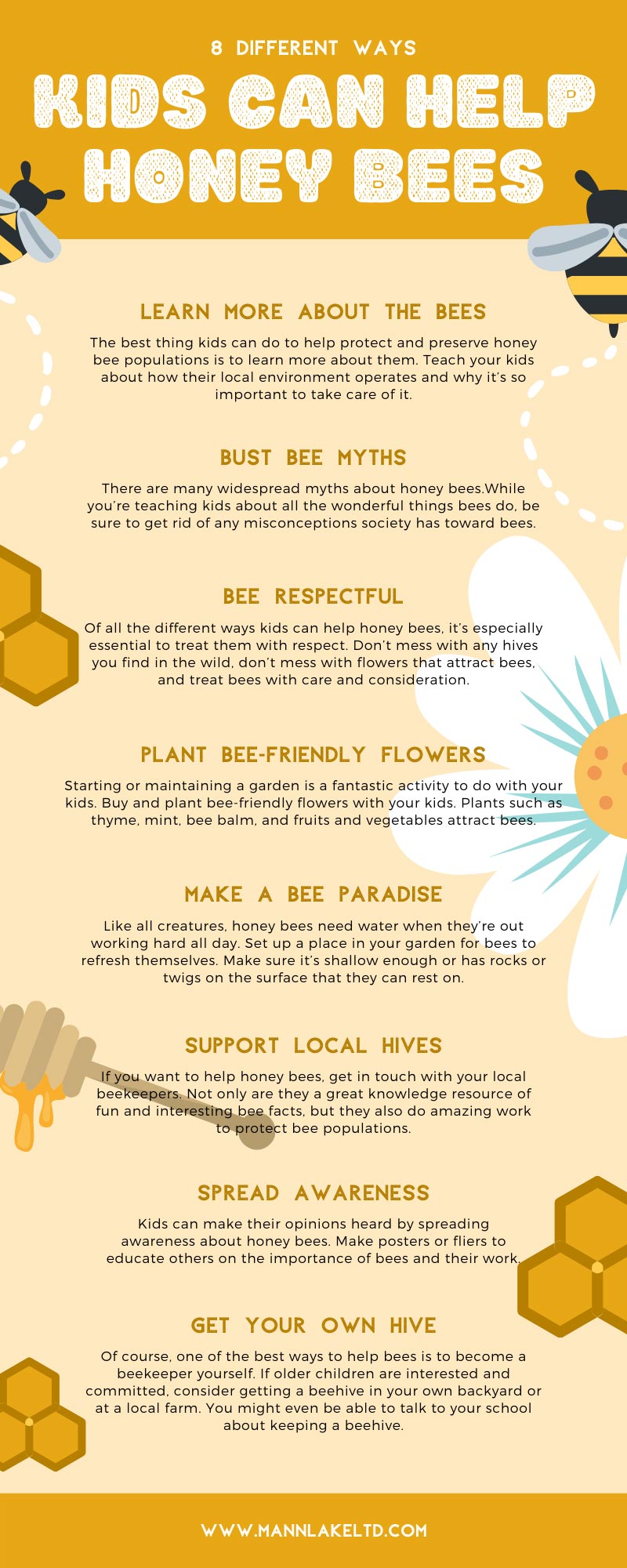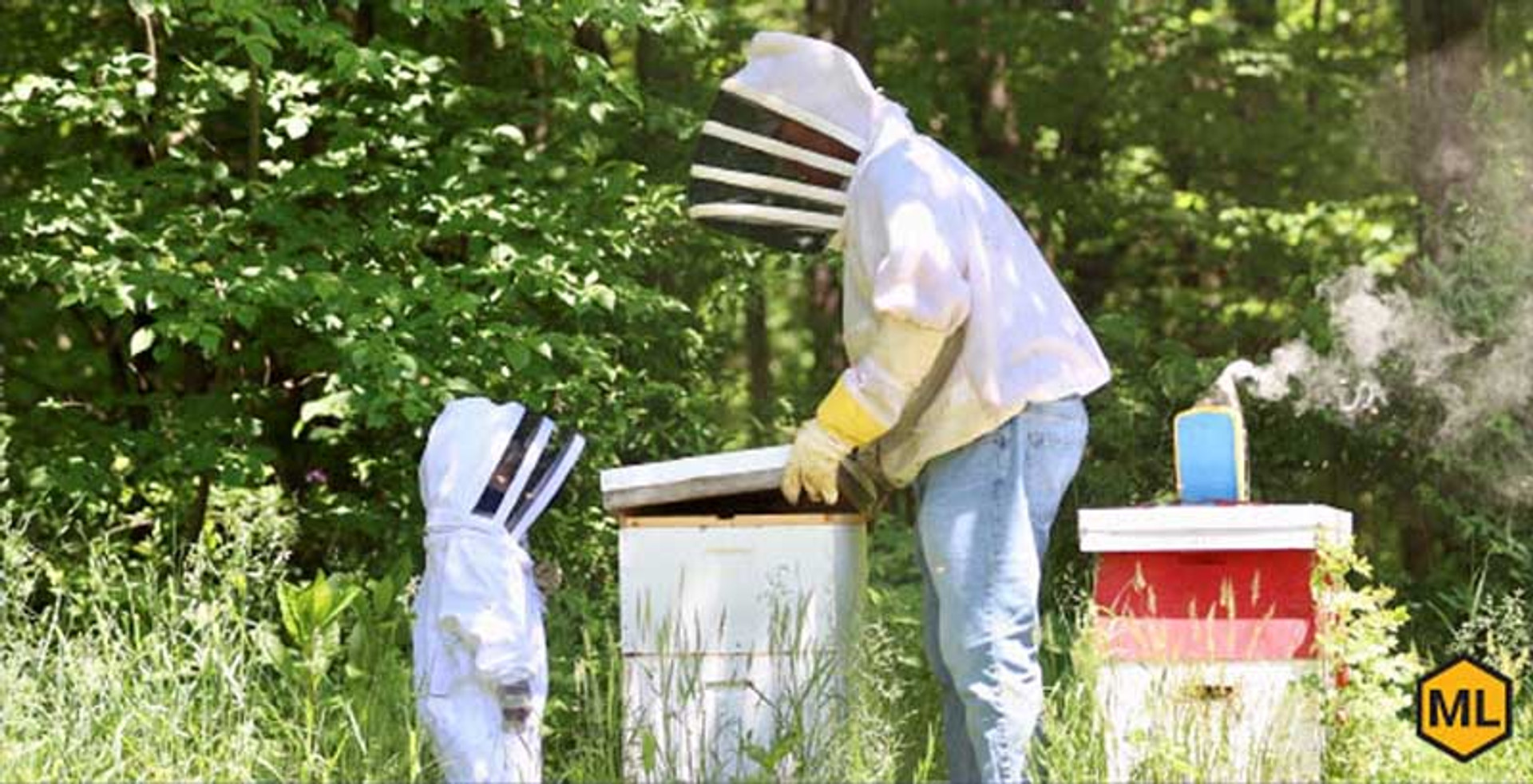8 Different Ways Kids Can Help Honey Bees
It’s essential for kids to learn more about the world around them. Now more than ever, the more we teach younger generations about their environment, the better equipped they are to help protect it as they grow up.
With bee populations on the decline and many vital crops in danger, honey bees need all the help they can get. As bee stewards, it’s our job to pass on valuable information to kids. It’s our hope that we can inspire conservation efforts and positive changes in agriculture and environmental policies that are currently damaging bees and other insects around the world.
Here are some different ways to teach kids how they can help save the bees and the environment as a whole.
1. Learn More About Bees
The best thing kids can do to help protect and preserve honey bee populations is to learn more about them. Teach your kids about the value of the local environment and why it’s so important to take care of it.
Get them interested in bees by explaining how a hive works and how worker bees pollinate flowers as they forage for nectar. You can buy or borrow bee books, educational tools, or other honey bee equipment to help children learn more about these productive little creatures.
When kids understand exactly how honey bees impact and benefit their environment, they’ll be more invested in advocating for and protecting them.
Be sure to check our YouTube channel for educational videos on all things beekeeping!
2. Bust Bee Myths
There are many widespread myths about honey bees. Unfortunately, these misconceptions can sometimes be harmful, leading to people fearing and harming bees. While teaching kids about all the wonderful things bees do, be sure to eliminate any misconceptions society has toward bees.
Teach them that bees only sting when defending themselves or their hive and that they’re naturally curious creatures. Bees might bump into or land on you if they’re investigating you, but they aren’t aggressive creatures. Tell children not to swat at bees or be afraid of them but just to let them be.
Taking the time to educate kids on the truth about bees can have a domino effect. As they learn and understand more about these productive little pollinators, they will be inspired to share with their friends and communities. Over time, the misconceptions will disappear, and people will better understand how bees operate and why they’re so vital to our environment.
3. Bee Respectful
While insects look and act extremely different from humans, they’re also living creatures. Of all the different ways kids can help honey bees, it’s especially essential to treat them with respect.
Honey bees are responsible for the pollination of nearly 80% of all flowering plants, including 130 fruits and vegetables. There’s no denying that these pollinators are hard at work all year round, and they deserve our respect and care.
Don’t mess with any hives you find in the wild and any native flowers that attract bees. Above all, always treat bees with care and consideration.
Pay attention when walking through the yard or garden, especially when you’re barefoot. If kids hold respect for bees, they’ll also learn to respect the rest of the world around them and all the living creatures within it.
4. Create a Pollinator Garden
Starting a garden is a fantastic activity to do with your kids. They get to be outside and active with their hands in the dirt while learning more about the world around them. Maintaining a garden takes responsibility, focus, and commitment, which are great skills for kids to learn from a young age.

Your garden can also double as an oasis for the native bees in the area, typically called a pollinator garden. To build this kind of garden, buy and plant bee-friendly flowers with your kids so they can learn about the best habitats for bees and other pollinators to thrive.
Flowering plants such as thyme, mint, bee balm, lavender, and fruits and vegetables attract pollinators and will encourage more bees to come to your area to forage for nectar.
It’s also important to have a range of plants and flowers that will bloom at different times throughout the year so the local bees will always have a diverse supply of food. For instance, try winter honeysuckle and clematis in the colder months and geraniums, thistle, and rosemary for the warm seasons. Whatever plants you choose, offering variety and diversity will satisfy all the pollinators in your garden.
While you’re working in the garden, resist the urge to pull up any weeds. While a neat garden might be visually appealing, some weeds are great resources for honey bees. Clovers and dandelions—two of the most common yard and garden weeds—are some of the bees’ favorite foraging destinations. Dandelions are fruitful for bees as they provide both pollen and nectar for our little pollinators.
5. Make a Bee Paradise
Plants aren’t the only thing bees will love in your garden. Like all creatures, honey bees need water when they’re out working hard all day. Set up a place in your garden for bees to refresh themselves whenever they please.
Make sure it’s shallow enough or has rocks or twigs on the surface that they can rest on. A bird bath or dish works great, but you can also let your kids get creative in making a water feature.

Another bee-friendly gardening tip is to stay away from pesticides. The chemicals in common pesticides are harmful to honey bees and other beneficial insects in the environment. Pesticides can seriously harm bees and even lead to habitat loss, devastating colonies all around the world.
Instead, use organic or DIY pest control solutions—and teach your kids to use them, too. Spray your plants and flowers with soap and citrus oil, pepper spray, or a salt spray. These small changes can make a huge difference in bee health and the environment you provide for all creatures and insects.
6. Support Local Hives
If you want to help save the bees, get in touch with your local beekeepers. Not only are they a great knowledge resource of fun and interesting bee facts, but they also do amazing work to protect the native bees in your area.
There are programs that let you fund a hive in return for updates, pictures, and some of its honey. You can also take the kids to your local farmers’ market, where beekeepers sell the local honey from their hives. These are great ways to support local beekeepers and ensure they can keep investing in their hives.
Many beekeepers also make and sell products made from beeswax, such as soaps and candles. While you’re there, kids also get the chance to talk to beekeepers about their bees, which is a great learning experience for everyone involved.
7. Spread Awareness
Protecting honey bees isn’t just a backyard job. Many laws and regulations are currently being debated that could significantly help bees. For example, some governments are banning pesticides that cause harm to bees and other beneficial pollinators and insects. Kids can make their opinions heard by spreading awareness about honey bees.
Make posters or fliers to educate others on the importance of bees and their work. Kids can share their knowledge about making bee-friendly gardens by suggesting the best flowering plants for native bees or supporting local hives.
This information can be posted on community bulletin boards, shared on social media platforms, or mailed to newspapers and government officials. Show kids that they can use their voice, knowledge, and creativity to make a difference in the world.
8. Get Your Own Hive
One of the best ways to save the bees is to become a beekeeper yourself. If older children are interested and committed, consider getting a hive kit or a beginner essentials starter kit in your backyard or at a local farm. You might even be able to talk to your school about keeping a beehive so the students can all pitch in and help.

If you’re totally new to beekeeping, Mann Lake carries a robust assortment of beginner essentials that can help you get started on your beekeeping adventure. There’s so much to know, but starting a new project with your kids is a fantastic way to teach them that they can learn something new at any age.
There are also many beekeepers who are happy to share their knowledge and experience with potential new members of the beekeeping community. No matter where it is, the chance to suit up and get some hands-on time with a honey bee population is a unique and exceptional experience. It might even turn into a life-long hobby and passion for you and your family.
The Final Buzz on Teaching Kids to Save the Bees
Bee conservancy is more crucial than ever, and the next generation can make a huge difference in the future of our buzzy little friends. Inspiring children to become bee stewards is a necessary step towards saving this delicate but necessary population, and we’re here to help!
Mann Lake is committed to educating people of all ages on how to save honey bee colonies worldwide, and we provide ample educational resources to do so. Explore our blog or watch our bee videos to learn more about honey bees and discover how you can teach kids to save bees and build a better tomorrow.


